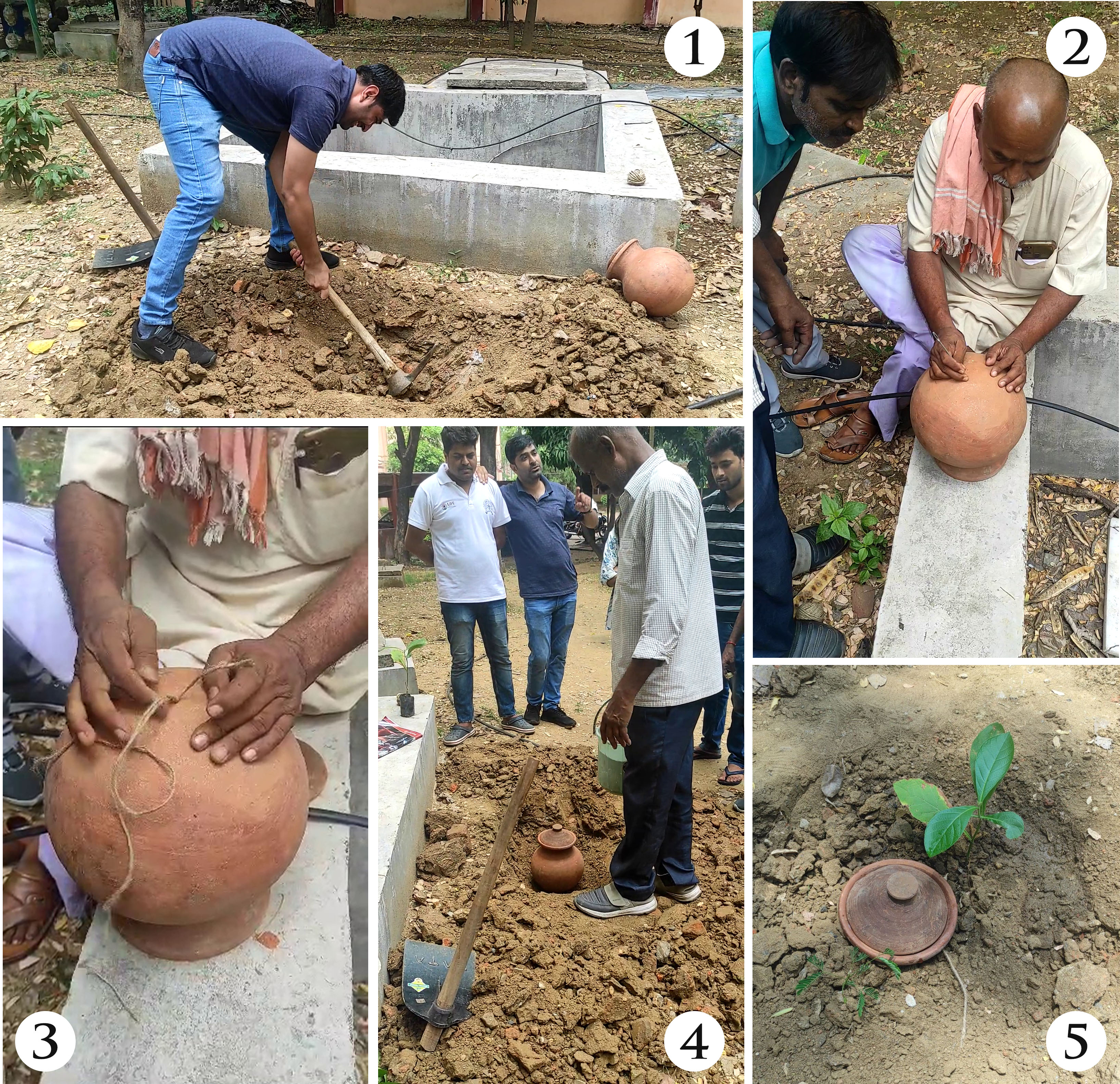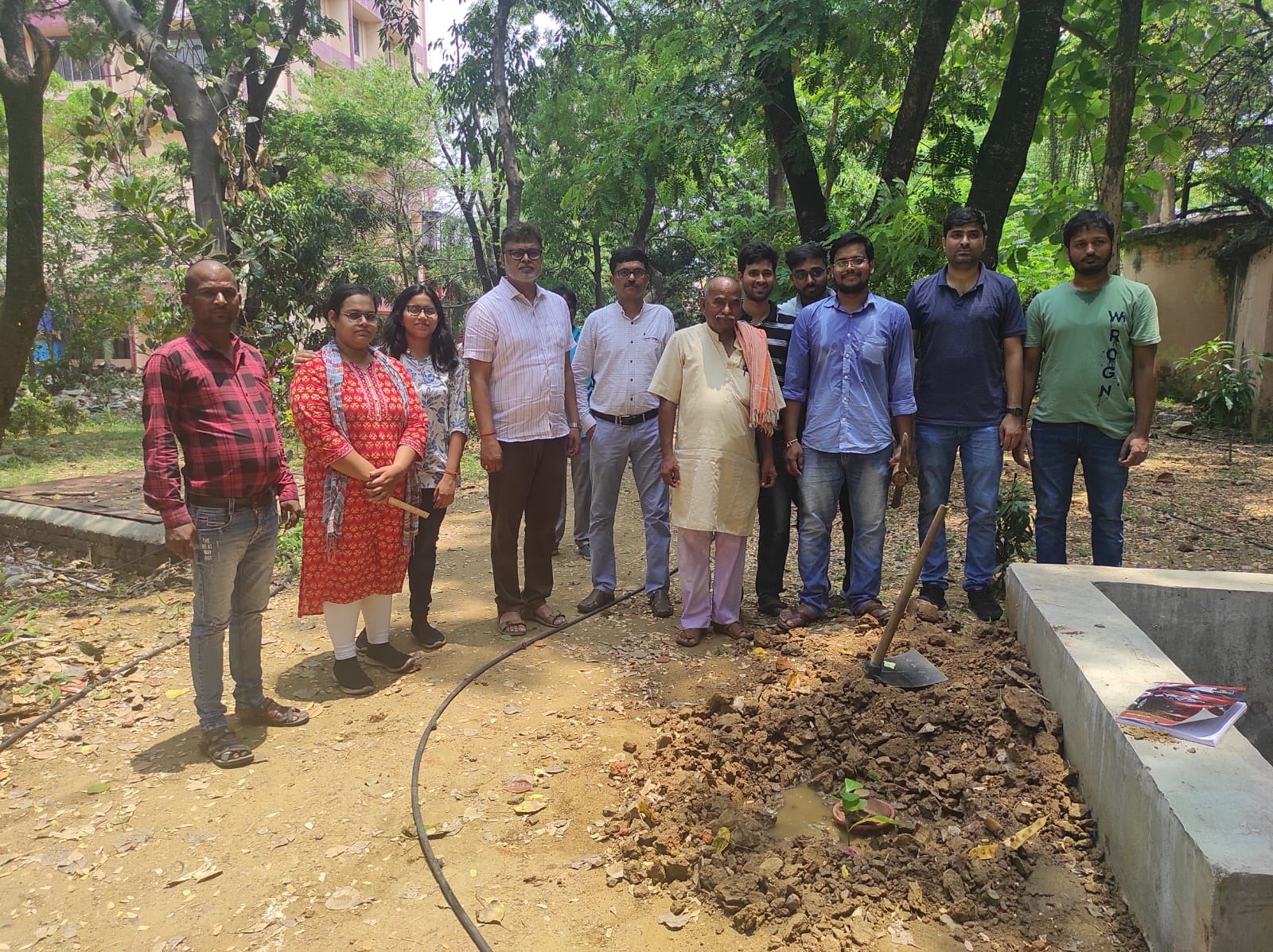पुनर्भरण विधि वृक्षारोपण
Matka Plantation using Recharge Technique
Date | 23rd June 2023:
Mr. Hemlal Mahato, Founder JSPR Agro Pvt. Ltd., Giridh, (Jharkhand, India) and his team visited Department of Environmental Science & Engineering, Indian Institute of Technology (ISM) Dhanbad on 23.06.2023 and gave a demo on Matka Plantation using recharge technique. Prof. Anshumali, Head, Department of Environmental Science & Engineering, IIT (ISM) Dhanbad & Coordinator, IIT(ISM) EIACP (PC-RP), Prof. B.K. Mishra, Associate Professor, Dept. of ESE, IIT(ISM) Dhanbad and Prof. Suresh Pandian E., Associate Professor, Dept. of ESE, IIT(ISM) Dhanbad along with students and research scholars were present during the demonstration.
The "matka plantation method" refers to a traditional technique used in certain regions to recharge groundwater using clay pots called "matkas" or "matkis." This method is commonly employed in areas facing water scarcity or where the water table has significantly depleted. In this technique water is filled in pots and buried in the ground near the roots of trees or plants. A small hole is made in the pot through which the water drips drop by drop and goes to the roots of the plants. Due to this, the roots get water as per the requirement and the plants remain green.
Here's an overview of the process:
Selecting the Site: Choose an appropriate location for the matka plantation based on factors such as soil type, proximity to water sources, and the availability of sunlight.
Digging the Pit: Dig a pit of suitable dimensions in the chosen location. The depth and size of the pit will depend on factors such as the soil's permeability and the water demand in the area.
Preparing the Matkas: Get clay pot or matka, which is typically porous and allow water to seep through. 3-4 small bundles of jute rope are placed inside the matka and one end of the jute rope is taken out through the tiny hole that is made at the bottom of the matka. Soak the matka in water for a few hours before planting.
Planting the Matkas: Place the soaked matka in the pit with its mouth facing upward. Ensure that the matka is positioned firmly and is at a uniform level. The ends of the jute ropes taken out of the tiny hole made at the bottom of the matka are laid by spreading them in the pit where plant is to be planted.
Backfilling: Fill the space around the matka with a mixture of soil, sand, and gravel. This backfill material should be porous and have good water-holding capacity to facilitate water percolation. Watering the Matkas: Pour water into the matka regularly, ensuring that the water is absorbed by the clay wall. This water will gradually seep into the surrounding soil and recharge the groundwater and also the laid jute ropes will help in reaching the water to the plant roots.
Maintenance: Regularly monitor the matka for cracks or damages and repair or replace them as needed. Keep the area around the matka free from debris and vegetation to prevent blockage.
What are the benefits of matka plantation?
- Water comes out from the pots as per the requirement of the plant.
- In summer season, the water of the pot will last from 7 to 15 days.
- Plants grow 20 to 30 percent faster.
- Improves water use efficiency by 50-70%.
- Water reaches directly to the roots of plants.
- Due to dryness of the surrounding land, the problem of weeds is less.
Glimpses of Demonstration of "Matka Plantation using Recharge Technique".

 Group Photo: Prof. Anshumali, Head, Dept. of ESE & Coordinator, EIACP (PC-RP), IIT(ISM) Dhanbad, Prof. B.K. Mishra, Assoc. Prof., Dept. of ESE, IIT(ISM) Dhanbad and Mr. Hemlal Mahato, Founder JSPR Agro Pvt. Ltd., Giridh, (Jharkhand, India) along with students and research scholars.
Group Photo: Prof. Anshumali, Head, Dept. of ESE & Coordinator, EIACP (PC-RP), IIT(ISM) Dhanbad, Prof. B.K. Mishra, Assoc. Prof., Dept. of ESE, IIT(ISM) Dhanbad and Mr. Hemlal Mahato, Founder JSPR Agro Pvt. Ltd., Giridh, (Jharkhand, India) along with students and research scholars.
.JPG) Prof. Anshumali, Head, Dept. of ESE & Coordinator, EIACP (PC-RP), IIT(ISM) Dhanbad, Prof. Suresh Pandian E., Assoc. Prof., Dept. of ESE, IIT(ISM) Dhanbad along with Mr. Hemlal Mahato, Founder JSPR Agro Pvt. Ltd., Giridh, (Jharkhand, India) and his team member at HOD/ESE Chamber. discussing future collaboration and activities to be undertaken.
Prof. Anshumali, Head, Dept. of ESE & Coordinator, EIACP (PC-RP), IIT(ISM) Dhanbad, Prof. Suresh Pandian E., Assoc. Prof., Dept. of ESE, IIT(ISM) Dhanbad along with Mr. Hemlal Mahato, Founder JSPR Agro Pvt. Ltd., Giridh, (Jharkhand, India) and his team member at HOD/ESE Chamber. discussing future collaboration and activities to be undertaken.
Prof. Anshumali, Head, Dept. of ESE & Coordinator, EIACP (PC-RP), IIT(ISM) Dhanbad gifted Mission LiFE t-shirt to Mr. Hemlal Mahato and his team member as a token of appreciation.
.png)
The Matka Plantation Recharge Technique (MPRT) is a nature-based solution to environmental problems especially restoration of mined out areas, riverfronts, degraded forest land, hilly terrains, agroforestry in rainfed areas etc. The MPRT is a very low-cost technique to achieve the REDD+ and NDC commitments made by the Government of India.
Newspaper Clippings
.png)
(Source: https://www.livehindustan.com/)